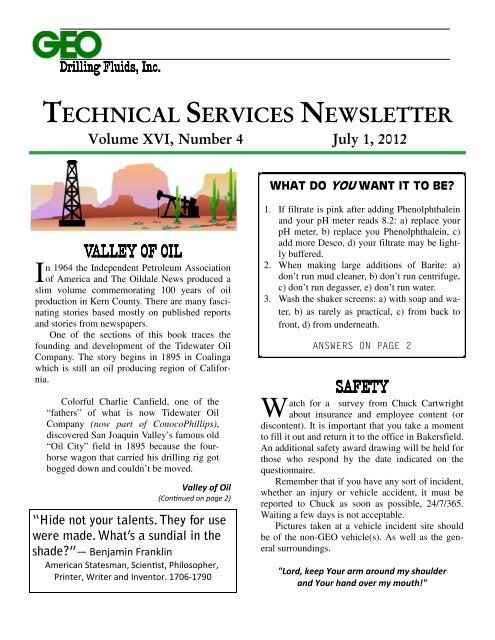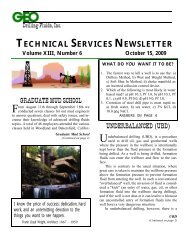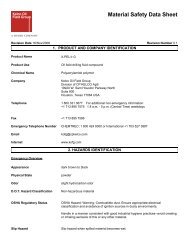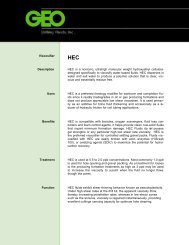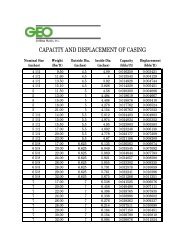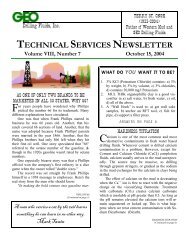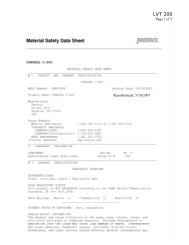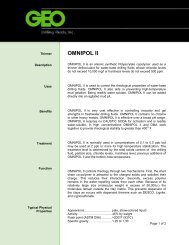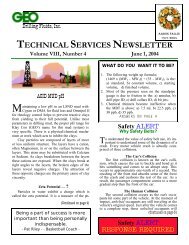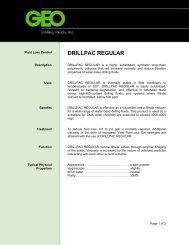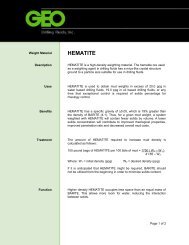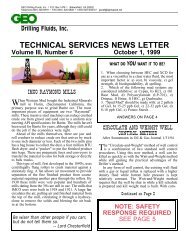Volume 16 Number 4 - GEO Drilling Fluids, Inc.
Volume 16 Number 4 - GEO Drilling Fluids, Inc.
Volume 16 Number 4 - GEO Drilling Fluids, Inc.
You also want an ePaper? Increase the reach of your titles
YUMPU automatically turns print PDFs into web optimized ePapers that Google loves.
<strong>Drilling</strong> <strong>Fluids</strong>, <strong>Inc</strong>.<br />
TECHNICAL SERVICES NEWSLETTER<br />
<strong>Volume</strong> XVI, <strong>Number</strong> 4 July 1, 2012<br />
WHAT DO YOU WANT IT TO BE?<br />
I<br />
VALLEY OF OIL<br />
n 1964 the Independent Petroleum Association<br />
of America and The Oildale News produced a<br />
slim volume commemorating 100 years of oil<br />
production in Kern County. There are many fascinating<br />
stories based mostly on published reports<br />
and stories from newspapers.<br />
One of the sections of this book traces the<br />
founding and development of the Tidewater Oil<br />
Company. The story begins in 1895 in Coalinga<br />
which is still an oil producing region of California.<br />
Colorful Charlie Canfield, one of the<br />
“fathers” of what is now Tidewater Oil<br />
Company (now part of ConocoPhillips),<br />
discovered San Joaquin Valley’s famous old<br />
“Oil City” field in 1895 because the fourhorse<br />
wagon that carried his drilling rig got<br />
bogged down and couldn’t be moved.<br />
Valley of Oil<br />
(Connued on page 2)<br />
“Hide not your talents. They for use<br />
were made. What’s a sundial in the<br />
shade?”― Benjamin Franklin<br />
American Statesman, Scienst, Philosopher,<br />
Printer, Writer and Inventor. 1706-1790<br />
1. If filtrate is pink after adding Phenolphthalein<br />
and your pH meter reads 8.2: a) replace your<br />
pH meter, b) replace you Phenolphthalein, c)<br />
add more Desco, d) your filtrate may be lightly<br />
buffered.<br />
2. When making large additions of Barite: a)<br />
don’t run mud cleaner, b) don’t run centrifuge,<br />
c) don’t run degasser, e) don’t run water.<br />
3. Wash the shaker screens: a) with soap and water,<br />
b) as rarely as practical, c) from back to<br />
front, d) from underneath.<br />
W<br />
ANSWERS ON PAGE 2<br />
SAFETY<br />
atch for a survey from Chuck Cartwright<br />
about insurance and employee content (or<br />
discontent). It is important that you take a moment<br />
to fill it out and return it to the office in Bakersfield.<br />
An additional safety award drawing will be held for<br />
those who respond by the date indicated on the<br />
questionnaire.<br />
Remember that if you have any sort of incident,<br />
whether an injury or vehicle accident, it must be<br />
reported to Chuck as soon as possible, 24/7/365.<br />
Waiting a few days is not acceptable.<br />
Pictures taken at a vehicle incident site should<br />
be of the non-<strong>GEO</strong> vehicle(s). As well as the general<br />
surroundings.<br />
"Lord, keep Your arm around my shoulder<br />
and Your hand over my mouth!"
TECHNICAL SERVICES NEWSLETTER VOLUME XVI NUMBER 4 July 1, 2012<br />
Canfield and a man named J. A. Chanslor,<br />
both former gold miners, had formed a partnership<br />
and after drilling some wells in the<br />
Los Angeles area, they shipped their rig to<br />
Coalinga where Canfield loaded it on a wagon<br />
and headed back into the hills to wildcat. A<br />
few miles from town the wagon sank down to<br />
its axles in an alkali dry-bog.<br />
After working furiously for several hours<br />
to get the wagon free, Canfield gave up in<br />
disgust and exclaimed, “Hell! This is just as<br />
good a place as any to drill.” He unloaded the<br />
old “fiddle rig” and put it to work right by the<br />
side of the road. The hole had barely been<br />
drilled to a depth of 400 feet when Charlie<br />
had himself an oil well that flowed light crude<br />
at the rate of 25 barrels a day.”<br />
Four years later, in 1899, a man named J. M.<br />
Ellwood discovered oil in the Kern River section of<br />
the San Joaquin Valley (about 7 miles north of Bakersfield)<br />
… at a depth of 75 feet. The shallow production<br />
was inexpensive to develop. This started<br />
such a rush of drilling that within a short time production<br />
of oil in California had tripled. Prices fell<br />
rapidly, and for some time crude oil could be<br />
bought for as little as 10 cents a barrel.<br />
THE MUD MAN’S CORNER<br />
Near Miss (or is it a Near Hit?)<br />
T<br />
he photograph below of a retort kit shows a<br />
problem with the power cord. There are several<br />
issues here. First and most obvious is that the insulation<br />
is badly broken. This can allow water to<br />
penetrate into the cord and plug causing a short circuit.<br />
It can also lead to bare wires presenting the<br />
possibility of a shock. Any time that a power cord<br />
develops a break in the insulation it should be replaced<br />
or repaired.<br />
The second problem shown here is not as clear.<br />
The reason the power cord insulation broke is that it<br />
was wrapped tightly around the unit while still<br />
plugged in whenever it was not in use. The stress of<br />
being tightly kinked right next to the plug led to the<br />
equipment failure. Power cords should be stored<br />
rolled into loops.<br />
ANSWERS TO WHAT DO YOU WANT IT TO BE?<br />
1. d) your filtrate may be lightly buffered<br />
2. a) don’t run mud cleaner<br />
3. c) from back to front<br />
PAGE 2<br />
Retort Etiquette<br />
If the retort results indicate a solids content that<br />
is unbelievably high there are several potential<br />
problems that have caused this effect. Perhaps the<br />
Retort<br />
(Connued on page 3)
TECHNICAL SERVICES NEWSLETTER VOLUME XVI NUMBER 4 July 1, 2012<br />
Retort<br />
(Connued from page 2)<br />
most common cause is that the Tube (see the photograph<br />
below) is plugged with oily residue. This can<br />
happen with oil base mud when the fatty acids<br />
cause the problem or in mud with crude oil in it<br />
where the asphaltenes and paraffins cool in the tube<br />
Exposed Wires<br />
Tube<br />
Condenser<br />
Threads<br />
Cell<br />
and harden. Clean the tube regularly with a pipe<br />
cleaner, drill or special wire brush. PetroDrill solvent<br />
should be used to rinse out the tube after every<br />
few tests.<br />
Thermostat<br />
High solids may be the result of the thermostat<br />
suddenly not working and the temperature not getting<br />
to the required 950° F. The thermostat usually<br />
fails catastrophically, with the retort not heating at<br />
all. Rarely does it go out of adjustment suddenly.<br />
Adjusting the thermostat should only be done when<br />
a 1000° F thermometer is available. Just guessing<br />
at how far to turn the adjusting screw can lead to<br />
overheating and serious damage.<br />
ball that is 50% larger than the cell diameter works<br />
well.<br />
Is the Mud Cleaner Throwing Out Barite?<br />
The recommended screen size to allow Barite to<br />
return to the mud system is anything coarser than<br />
200 API. Be sure to use the API size, not the part<br />
number or other mesh designations.<br />
In order to determine the content of the solids<br />
going to the sump you should catch a sample and<br />
measure the density (specific gravity) with the mud<br />
balance. If the material is too dry to get a good<br />
weight a small amount of water may be added. This<br />
in no way effects the results. Be sure not to add<br />
enough water that separation starts to occur.<br />
Take the same material from the mud scale and<br />
fill a retort. With the retort results you can determine<br />
the percent barite. This can be done on the<br />
<strong>GEO</strong> <strong>Drilling</strong> <strong>Fluids</strong> mud report by simply substituting<br />
the mud weight and retort results from the<br />
mud cleaner for the mud test results in the mud<br />
checks section. The Daily Mud Report will show<br />
the amount of barite being discarded for every bbl<br />
of material going off the slide.<br />
North Dakota Dewatering<br />
This picture shows a rig in North Dakota. In the<br />
foreground is a dewatering unit. This equipment is<br />
used to remove the finest solids from drilling mud.<br />
When the horizontal section is drilled with salt water<br />
the dewatering unit can maintain the corrected<br />
solids content at or near 0%.<br />
Steel Wool<br />
Steel wool is used in the retort to keep the boiling<br />
mud from getting to the tube before it is converted<br />
to steam. The steel wool should be designated<br />
000 or 0000 in order to be fine enough to provide<br />
a proper barrier. The amount of steel wool to<br />
use is learned by experience, but if you use too<br />
much it will restrict the flow of steam while using<br />
too little will allow whole mud to pass over to the<br />
condenser and into the graduated cylinder. A soft<br />
PAGE 3<br />
<strong>GEO</strong> ZERO-LW Dewatering Unit.
TECHNICAL SERVICES NEWSLETTER VOLUME XVI NUMBER 4 July 1, 2012<br />
THERMAL EXPANSION<br />
Effect of Temperature on Mud Weight<br />
in PetroDrill Systems<br />
By Aaron Philips<br />
W<br />
ith few exemptions, materials expand when<br />
they are heated. As the temperature rises in<br />
our PetroDrill oil base mud system, both the oil and<br />
the salt water in the fluid expand. This expansion<br />
can be observed when the mud weight at the flow<br />
line is lower than at the suction. As the mud cools in<br />
the surface pits the liquids contract resulting in increased<br />
mud weight. When precise mud weight<br />
control is critical it is important to be able to calculate<br />
the expected change in mud weight as the temperature<br />
of the fluid changes.<br />
PetroDrill has three main components: LVT-200<br />
enheit. With LVT-200 more data is available and a<br />
range of expansion rates may me used for various<br />
temperatures and pressures (See Table 1). These<br />
expansion coefficients are useful when calculating<br />
volume changes in the hole but for surface density<br />
changes the only coefficient needed for most situations<br />
is 0.000374. This formula is for surface mud:<br />
MW 2 =<br />
MW 1<br />
(S + W x (1 + 0.000358 x ΔT) + O x (1 + 0.000374 x ΔT))<br />
Other Uses<br />
Due to the contraction of the fluid as it cools<br />
after a long trip the mud weight in the pits can be<br />
very elevated. By using the above equation one can<br />
demonstrate what the mud weight will be once the<br />
system has returned to the normal operating temperature.<br />
The expansion of mud in the well bore as<br />
it heats up can cause a small amount of flow when<br />
pumps are turned off. This can lead to the incorrect<br />
assumption that the well is flowing if only very<br />
short flow checks are taken. For the expansion of<br />
mud in the well bore the expansion coefficients utilized<br />
to determine the expected change in volume<br />
depend on the bottom hole temperatures and pressures<br />
and are calculated using Table 1.<br />
oil, CaCl 2 water, and solids (including clays, drill<br />
solids and Barite). Even over the most extreme temperature<br />
range that PetroDrill goes through the solids<br />
do not expand to any measurable degree. The<br />
liquids, LVT-200 and CaCl 2 water, do expand significantly<br />
over the same temperature range.<br />
Calculations<br />
To calculate the mud weight at a different temperature<br />
(MW 2 ) the following information is used:<br />
1. Change in temperature = ∆T<br />
2. Known mud weight = MW 1<br />
3. Percent oil from retort = O<br />
4. Corrected percent solids = S<br />
5. Corrected percent water = W<br />
CaCl 2 water expands 0.0358% per degree Fahr-<br />
PAGE 4<br />
Pressure<br />
(PSI)<br />
Expansion per °F<br />
75 °F to 200 °F<br />
Expansion per °F<br />
200 °F to 300 °F<br />
0 0.000374 0.000417<br />
1,500 0.000354 0.000380<br />
3,000 0.000336 0.000351<br />
4,500 0.000331 0.000342<br />
6,000 0.000321 0.000328<br />
7,500 0.000306 0.000308<br />
9,000 0.000294 0.000292<br />
10,500 0.000283 0.000278<br />
12,000 0.000272 0.000268<br />
13,500 0.000263 0.000259<br />
15,000 0.000255 0.000251<br />
Table 1: Change in volume of LVT-200 as temperature<br />
is changed over normal operang temperatures and<br />
pressures of wells.
TECHNICAL SERVICES NEWSLETTER VOLUME XVI NUMBER 4 July 1, 2012<br />
RELIEF ETIQUETTE<br />
How you would like it to be.<br />
Don Boulet, Operations Manager, Northern California<br />
B<br />
ack in the old days (in the 1970’s—1980’s)<br />
relieving a mud engineer was rare as most<br />
jobs were done by a single person without days off.<br />
Now we relieve each other as often as every week.<br />
What you do to make the job seamless from the<br />
customer’s perspective is critical to a good job with<br />
rave reviews.<br />
Simplify Your Communication<br />
It’s not about big words or long explanations.<br />
It’s about keeping it simple. When you start telling<br />
the story of what has been happening make the beginning<br />
exciting so you get his attention. Start with<br />
the remarkable success or disaster. Then go over the<br />
meat of the matter, discussing relations with the<br />
hands, product consumption, and how the wind is<br />
blowing with the DSM/Company Man. Finish up<br />
with a review of the current activity.<br />
Look Them in the Eye<br />
Talking face to face is effective. Cell phone to<br />
cell phone is NOT as effective and should only be<br />
used as a last resort. Communication has to be a<br />
two way street. When you are seeing the reactions<br />
of the other person you can tell if they are getting<br />
the importance of what you are saying. If they are<br />
staring out the window just waiting for you to drive<br />
off so they can go about their business without your<br />
You may be wondering why it’s<br />
always the mud man’s fault…<br />
there are two thing that go in the<br />
hole, there’s steel and there’s<br />
mud… and it’s prey hard to screw<br />
up steel.<br />
input they may need to be jolted back to reality.<br />
Tell the Truth!<br />
There is no better way to establish your credibility<br />
than to tell the truth. Come on… he’s going to<br />
check it after you leave. Regardless of what the official<br />
line is you gain nothing by failing to fully disclose<br />
the current situation. It may be in the process<br />
of being changed or fixed but your relief still needs<br />
to know.<br />
Get a Response<br />
One person doing all the talking is NOT the<br />
form of communication that makes for good relief.<br />
Respond to what you are hearing. Ask questions.<br />
Become a part of the process, not just an empty<br />
vessel being filled with information.<br />
Count the Material<br />
Daily counting of the material on location is the<br />
only accurate way to determine what is being used.<br />
Relief day gives you a chance to have two sets of<br />
eyes on the process to catch mistakes. Those hidden<br />
sacks of GeoZan that are laying on a partial pallet<br />
of sawdust. Or the pallet of Desco with 10 sacks<br />
missing from the far side. The last thing you want is<br />
to finish a well and be way off on the inventory.<br />
Customers don’t like those surprises, whether in<br />
their favor or not.<br />
One Final Thought<br />
Keep this in mind as you interact with each other<br />
as well as with the roughnecks. This is a quote<br />
from Charles Schwab, 1870-1939, who was the<br />
head of Bethlehem Steel. “I have yet to find the<br />
man, however exalted his station, who did<br />
not do better work and put forth greater effort<br />
under a spirit of approval than under a<br />
spirit of criticism.”<br />
Barite Ore<br />
PAGE 5


